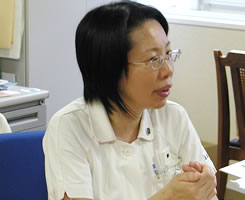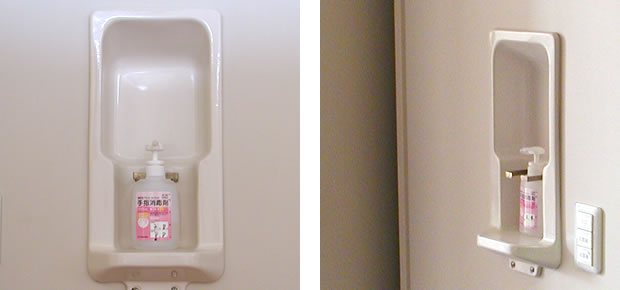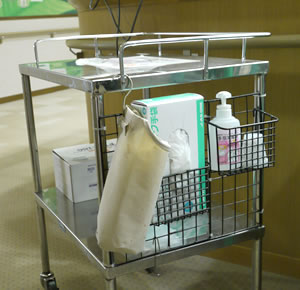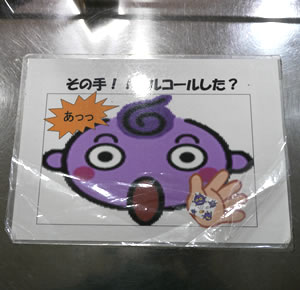- Home
- Healthcare Case Study
- Pursuing Correct Hand Hygiene Practices
Pursuing Correct Hand Hygiene Practices

Chugoku Central Hospital
-
Address:148-13 Miyukicho Oaza Kamiiwanari, Fukuyama-shi, Hiroshima, Japan
-
Number of beds:277 (General 271, TB 6)
-
Total number of staff:469
-
Number of surgeries:1,800 (April 2010 to March 2011)
-
Website:http://www.kouritu-cch.jp/
※Saraya Co., Ltd.'s privacy policy does not apply to the linked website.
Please refer to the privacy policy posted on the site.


Alcohol-based hand rub
Steps taken to introduce Sanisara W
- What is the background that led you to consider introducing Sanisara W?
Prior to the introduction of Sanisara W, we used liquid hand disinfectants from other companies.
For the liquid hand disinfectants, the volume of the disinfectant required for a proper hand rub was specified to be 3 ml. However, it was difficult to use a sufficient volume as the liquid disinfectant dripped out of the hands. When we observed the nurses performing hand hygiene, the volume of the disinfectant was apparently inadequate, so we started considering the introduction of a gel-type disinfectant that does not drip.
- Why did you choose Sanisara W?
The main reasons were its excellent usability and the fact that it does not drip. The other gels were similar in the aspect of not dripping, but Sanisara W was superior because there is no stickiness, which interferes with the donning and removing of gloves, and it has a smooth feeling without aggregation of the gel, even after using it multiple times. Also, given the rotation of the hand disinfectant and the space for installation, the volume of 250 ml was convenient for us.
As a result of comprehensively taking into account the opinions of the participants at the link nurses' meeting, and of nurses with rough hands, Sanisara W was chosen.
 |
||
| Ms. Takahashi (Nurse) Besides working as a full time nurse for medical safety management, she also offers courses on infection control to raise the level of knowledge. |
After the introduction of Sanisara W
- How did you inform the staff members about the use of the gel-type of
hand disinfectant?
And what was the feedback?
Given the possibility of inadequate disinfection of the fingertips with the gel-type hand disnfectant, we advised the staff to first spread the gel disinfectant on their palms and disinfect their fingertips before spreading it all over their hands.
To date, we have not received any negative feedback about issues such as disturbance of donning gloves, aggregation of the gel, or skin irritation. We think Sanisara W is well accepted by staff for good hand hygiene practice at our hospital.
- Where do you place Sanisara W?
We place it in patients' rooms, on computer wagons and on trolleys. (Photo 1,2) Placing hand disinfectants in the patients' rooms is standard practice in our hospital. In addition, we place it on the computer wagons as they are frequently touched and there is a risk of cross-contamination through shared equipment such as computers. Hand disinfectants are also placed on the trolleys so that hand hygiene can be performed immediately before and after treatments/procedures.
 |
||
| Photo 1: Hand disinfectants installed in each room. It is installed to avoid the risk of cross-contamination via doors. |
 |
 |
||
| Photo 2: Hand disinfectant placed beside a trolley. | Photo 3: Poster attached to a trolley. |
- What kind of hand hygiene education/training activities are you engaged
in?
The Link Nurse Association plays a central role in conducting technical checks on the timing of hand hygiene and glove use for nurses. Particular emphasis has been placed on hand disinfection before and after glove use and before clean/aseptic procedures such as the preparation of drugs. For this reason, various measures have been taken, such as attaching posters to the trolleys to encourage the implementation of hand hygiene (Photo 3).
Our hospital has held ten seminars per year on infection control for the last six years, run by the link nurse in charge of staff education. Currently, about 120 nurses have attended these seminars, which makes up a third of all the nurses working in our hospital. Thus, we can say that the knowledge level of the Link Nurse Association, organised by those educated members, is maintained at a high level.
Dissemination of hand hygiene to other paramedics and doctors is an ongoing challenge. We are planning to conduct demonstrations and give lectures on hand hygiene to the Clinical Technologists on how to don and remove personal protective equipment and how to improve the patient environment, etc., which are the basics of infection control measures. For the doctors, we are checking their hand hygiene procedures during the ward rounds.
NEXT STEP
- Do you have anything you would like to improve about the current
situation?
It appears that, in our hospital, hand washing with plain soap and running water is more common than hand disinfection with alcohol-based hand rubs . The CDC's hand hygiene guidelines recommend the use of alcohol-based hand rubs in the absence of visible dirt and that the use of a hand disinfectant should be encouraged more than soap in light of the incidence of hand roughness and disinfection efficacy. We plan to share the correct information and disseminate it thoroughly. At the same time, we would like to remind staff about the WHO's "five moments for hand hygiene" as well.
- What are the challenges for the future?
Most of our staff recognise how healthcare professionals can transmit pathogenic microorganisms, but this is not accompanied by action, so we believe it is important to motivate them to actively implement hand hygiene in the future. For this reason, we would like to make it a major goal that all medical staff at our hospital understand the meaning of standard precautions, including hand hygiene, and are able to fully implement them. We will ensure this by focusing on education about infection control measures.
Interviewees

Ms. Midori Takahashi
Background
- 1985: Began working at Chugoku Central Hospital
- 2006: Certified as an Infection Control Nurse
Editor's Notes
Improving the sanitation, the environment, and health of the world.
Social

© Copyright Saraya.Co.Ltd 2024 All rights reserved.